Introduction: A Versatile Utrecht Master
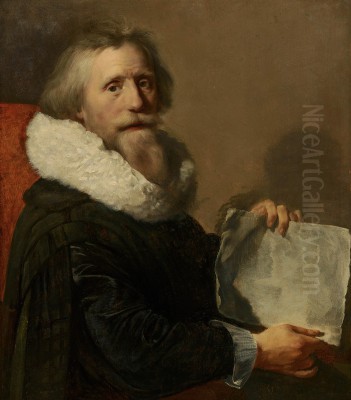
Paulus Jansz. Moreelse (1571–1638) stands as a significant figure in the rich tapestry of the Dutch Golden Age. Born and primarily active in the vibrant city of Utrecht, Moreelse was not merely a painter but a multifaceted talent whose influence extended into architecture and civic administration. He is best remembered today as a prolific and highly sought-after portrait painter, capturing the likenesses of the Dutch elite with elegance and precision. However, his contributions also encompass historical and mythological subjects, graphic arts, and important architectural designs that shaped the urban landscape of his hometown. Flourishing during the Baroque period, Moreelse skillfully blended influences from his native Netherlands with lessons learned from Italian masters, creating a distinct artistic identity that earned him considerable renown during his lifetime and secured his place in art history. His career exemplifies the dynamic interplay between artistic creation, social engagement, and civic duty characteristic of successful figures in the prosperous Dutch Republic.
Early Life and Formative Training
Paulus Moreelse was born in Utrecht in 1571 into a prominent family, which likely provided him with advantages in pursuing an artistic career. His early artistic education began under the tutelage of the Delft master portraitist, Michiel Jansz. van Mierevelt. Van Mierevelt was arguably the most successful portrait painter in the Dutch Republic during the early 17th century, known for his meticulous detail, refined finish, and ability to convey the status of his sitters. This apprenticeship, probably lasting about two years, grounded Moreelse in the essential techniques of portraiture and the prevailing standards of quality demanded by discerning patrons. The precise, almost enamel-like finish often seen in Van Mierevelt's work left a discernible mark on Moreelse's early style, particularly in his attention to costume and texture.
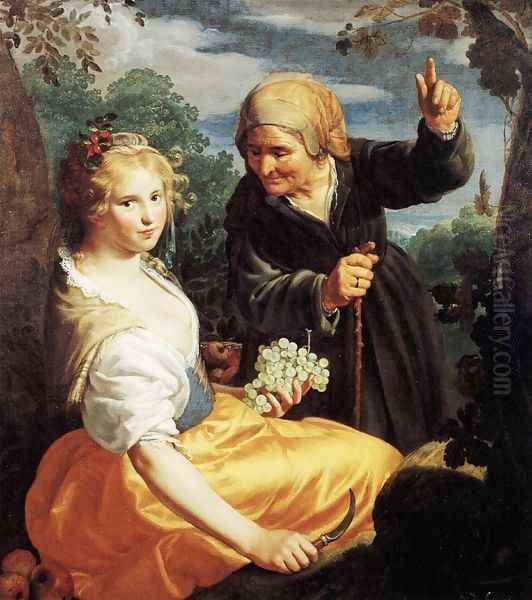
Following his training in Delft, Moreelse, like many ambitious Northern European artists of his time, embarked on a crucial journey to Italy before 1596. This period abroad was essential for absorbing the innovations of the Italian Renaissance and the burgeoning Baroque movement. While specific details of his itinerary are scarce, it is highly probable he visited major artistic centers like Rome and perhaps Venice. In Italy, he would have encountered firsthand the works of Renaissance giants and contemporary masters, including the revolutionary art of Caravaggio, whose dramatic use of light and shadow (chiaroscuro) and intense realism were transforming European painting. This exposure broadened Moreelse's artistic horizons significantly, introducing him to different compositional strategies, a bolder handling of paint, and a wider range of subject matter beyond portraiture. The Italian experience undoubtedly contributed to the development of his more mature, Baroque-inflected style upon his return to the Netherlands.
Establishing a Career in Utrecht
Upon returning from Italy, Paulus Moreelse settled back in his native Utrecht around 1596. He quickly established himself as an independent master, joining the local painters' guild, which at that time was still the Zadelaarsgilde (Saddlers' Guild), encompassing various crafts including painters. Utrecht was a unique artistic center within the Dutch Republic, maintaining strong ties to Catholic traditions and Italian art, partly due to its history as an episcopal see. This environment fostered a different artistic climate compared to the more commercially driven cities like Amsterdam or Haarlem. Moreelse's talent and Italian experience positioned him well within this context.
A pivotal moment in Moreelse's career and for the Utrecht art scene came in 1611. Alongside the influential painter Abraham Bloemaert, Moreelse played a leading role in founding a new, independent Guild of Saint Luke (Sint-Lucasgilde) specifically for painters and sculptors, separating them from the craftspeople in the Zadelaarsgilde. This move elevated the status of visual artists in the city. Moreelse's prominence was immediately recognized as he was elected the first dean (deken) of the new guild. This position not only reflected his artistic standing but also his organizational skills and respect among his peers. The guild served as a crucial institution for regulating the profession, training apprentices, and maintaining quality standards, and Moreelse's leadership was instrumental in its successful establishment.
Artistic Style: Blending Dutch Detail and Italian Flair
Paulus Moreelse's artistic style evolved throughout his career, reflecting a synthesis of his Dutch training and his Italian experiences, all within the broader context of the European Baroque. His foundation under Michiel van Mierevelt provided him with a mastery of detailed representation, particularly evident in his rendering of fabrics, lace, and jewelry – crucial elements in conveying the wealth and status of his portrait sitters. This meticulousness remained a hallmark of his work, aligning with the Dutch preference for realism and fine finish.
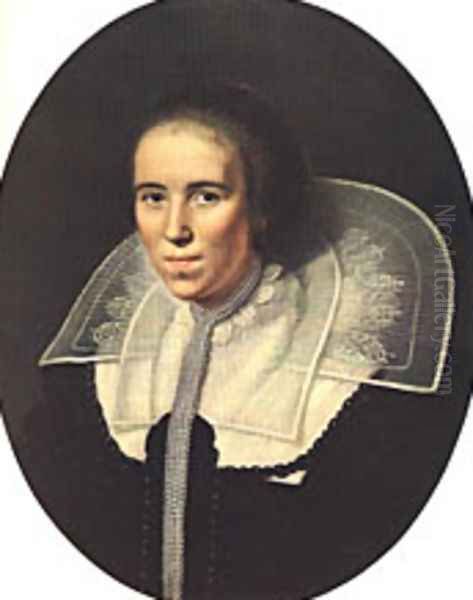
However, Moreelse's style was not merely a continuation of his teacher's. His time in Italy introduced him to the dynamism and emotional intensity of the Baroque. He absorbed the lessons of Italian masters, possibly including the dramatic lighting techniques pioneered by Caravaggio, although Moreelse's use of chiaroscuro is generally softer and less stark than that of the Utrecht Caravaggisti like Gerard van Honthorst or Dirck van Baburen. His compositions often show a greater sense of movement and a more relaxed pose compared to the sometimes rigid formality of earlier Dutch portraiture. He employed a rich color palette and demonstrated a skillful handling of paint, sometimes using freer brushstrokes alongside highly detailed passages.
While primarily a portraitist, his history and mythological paintings allowed for a more overt display of Baroque sensibilities, featuring dynamic arrangements of figures, expressive gestures, and often sensual undertones, as seen in works like Vertumnus and Pomona. Some art historians also note a potential influence from Peter Paul Rubens, the Flemish Baroque giant, particularly in the vitality and robust forms found in some of Moreelse's figures, though direct links are debated. Ultimately, Moreelse forged a successful style that balanced Dutch precision with Italianate grace and Baroque dynamism, appealing perfectly to the tastes of his affluent clientele.
The Celebrated Portraitist
Portraiture formed the bedrock of Paulus Moreelse's artistic output and reputation. He received numerous commissions from the elite of Utrecht and beyond, including patrician families, civic officials, and members of the nobility. His ability to capture not only a physical likeness but also an air of dignity and social standing made him exceptionally popular. His portraits are characterized by their elegance, refined execution, and careful attention to the luxurious details of clothing and accessories, which served as important markers of status in 17th-century Dutch society.
Among his notable portraits is the likeness of Maria van Utrecht (also known as Maria van Reede van Renswoude), painted around 1615. This work exemplifies his skill in rendering intricate lace collars and cuffs, rich fabrics, and conveying a sense of composed authority. Another significant work is Two Girls' Portraits (1622), housed in the Centraal Museum, Utrecht, showcasing his ability to capture the innocence and charm of youth while still adhering to the conventions of formal portraiture.
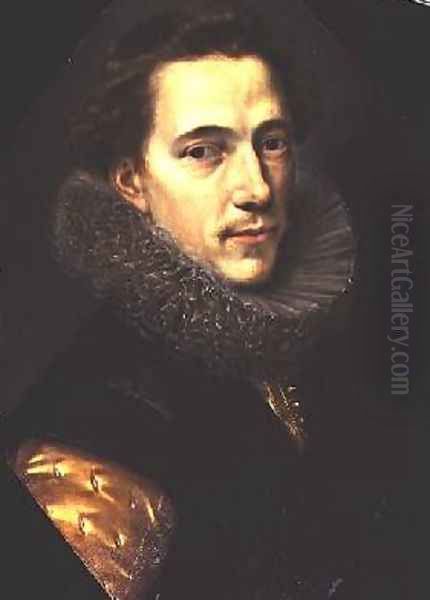
Moreelse also painted tronies – character studies or head-and-shoulders paintings exploring particular types or expressions, often featuring figures in exotic or pastoral costume. A famous example often discussed in this context, though sometimes debated as a tronie or allegorical portrait, is the Girl at the Mirror (circa 1627). This captivating image depicts a young woman, richly dressed, gazing at her reflection. It combines elements of portraiture with potential vanitas themes (contemplating beauty and mortality) or allegories of sight or vanity, demonstrating Moreelse's engagement with more complex thematic content even within portrait-like formats. His consistent quality and fashionable style ensured a steady stream of commissions throughout his career, making him one of the leading portrait painters of his generation alongside contemporaries like Frans Hals in Haarlem, though Moreelse's style remained generally more polished and less overtly bravura.
History Painting and Mythological Scenes
While portraiture was his primary focus, Paulus Moreelse also engaged with history painting, encompassing biblical, mythological, and allegorical subjects. These works allowed him greater freedom in composition and narrative expression compared to the constraints of portrait commissions. His history paintings often reflect the influence of Italian art, particularly in their choice of classical themes and dynamic figure arrangements, aligning with the broader European Baroque interest in classical antiquity and dramatic storytelling.
A well-known example of his mythological work is Vertumnus and Pomona (c. 1630). This subject, derived from Ovid's Metamorphoses, depicts the Roman god of seasons, Vertumnus, disguised as an old woman, attempting to woo the beautiful nymph Pomona, goddess of fruit trees. The theme was popular in the Netherlands, often carrying erotic undertones and celebrating nature's bounty. Moreelse's rendition typically features lush landscapes or garden settings, elegantly posed figures, and a rich palette, showcasing his ability to blend narrative with decorative appeal.
Another mythological subject associated with Moreelse is Diana and Callisto, also from Ovid. While original paintings exist, the composition is also known through engravings made by contemporaries like Jan Saenredam after Moreelse's designs. This indicates that his history paintings were valued enough to be disseminated through prints, reaching a wider audience. These works often display a sensuous treatment of the female nude, handled with classical grace but infused with Baroque vitality. Although less numerous than his portraits, Moreelse's history paintings demonstrate his versatility and his connection to the international currents of Baroque art, particularly the classicizing tendencies seen alongside the more dramatic Caravaggist style prevalent in Utrecht.
Contributions to Graphic Art
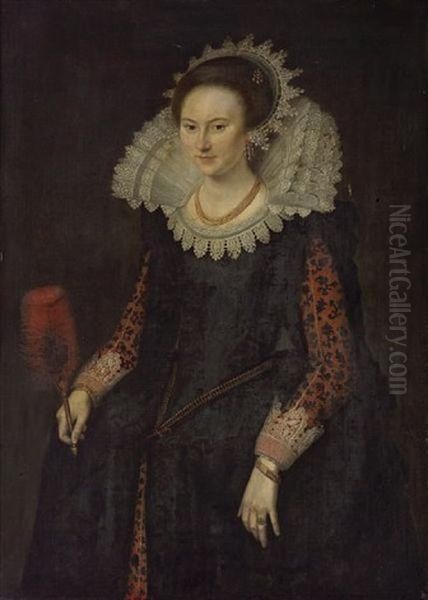
Beyond painting, Paulus Moreelse also made contributions to the graphic arts, specifically through woodcuts. While his output in this medium was relatively small compared to his paintings, his chiaroscuro woodcuts are noteworthy. Chiaroscuro woodcut is a technique using multiple blocks inked in different tones of the same color (often shades of grey, brown, or green) to create effects of light and shadow, mimicking the appearance of wash drawings or paintings. This technique had been popular in Italy and Germany in the 16th century, and artists like Hendrick Goltzius had revived interest in it in the Netherlands.
Moreelse produced a few striking examples, most famously two versions of The Death of Lucretia (early 17th century). This tragic subject from Roman history depicts the virtuous noblewoman Lucretia taking her own life after being dishonored. Moreelse's woodcuts treat the theme with dramatic intensity characteristic of the Baroque. One version is particularly noted for its dynamic composition, showing Lucretia collapsing, dagger in hand, with her chair overturning beside her – a detail reportedly intended to heighten the sense of sudden violence and tragedy.
These woodcuts are significant not only for their technical skill and expressive power but also for their potential influence. Art historians have noted similarities between Moreelse's graphic work and that of the young Rembrandt van Rijn. It is suggested that Rembrandt may have seen and even imitated aspects of Moreelse's prints early in his career. This connection underscores the circulation of artistic ideas through prints and highlights Moreelse's role within the broader network of Dutch art, extending beyond his immediate circle in Utrecht. His engagement with printmaking, though limited, demonstrates his exploration of different artistic media and techniques.
Architectural Endeavors and Urban Vision
Paulus Moreelse's talents were not confined to the canvas or the printing block; he was also active as an architect and involved in the urban development of Utrecht. His most significant architectural achievement was the design of the Catharijnepoort (St. Catherine's Gate), one of Utrecht's city gates, constructed around 1621-1625 (though sources sometimes vary on exact dates). This structure is often cited as one of the earliest examples of pure Classicism in Utrecht architecture. Moreelse designed it based on classical principles, likely drawing inspiration from Italian architectural treatises by figures like Serlio or Palladio, which he may have encountered during his travels or through published editions. The gate featured classical elements like pilasters, pediments, and a clear, symmetrical structure, marking a departure from the more traditional Dutch Renaissance styles. Although the gate itself was later demolished, its design is known through drawings and descriptions, confirming Moreelse's role as an early proponent of architectural Classicism in the city.
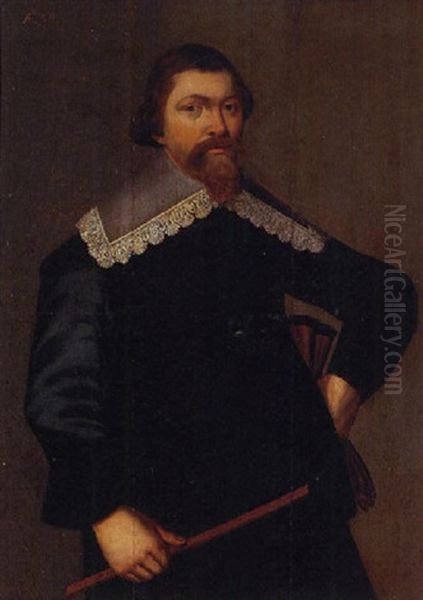
Beyond specific building designs, Moreelse demonstrated a keen interest in the overall planning and development of Utrecht. As a respected citizen and member of the city council (raadslid), he was involved in discussions about urban expansion. In 1626, he reportedly put forward proposals for enlarging the city, reflecting a forward-thinking vision for Utrecht's growth and modernization. His involvement in the founding of Utrecht University in 1636 further underscores his commitment to the city's cultural and intellectual advancement. This combination of artistic practice and civic engagement in architecture and urban planning highlights Moreelse's prominent position in Utrecht society and his contribution to shaping the physical and cultural landscape of his time.
Civic Life, Social Standing, and Influence
Paulus Moreelse was more than just an artist; he was a prominent and respected figure in Utrecht's civic and social life. His success as a painter and architect, combined with his family background and active participation in public affairs, afforded him considerable status. His election as the first dean of the Guild of Saint Luke in 1611 was an early indicator of the esteem in which his colleagues held him. This role involved not only administrative duties but also representing the interests of the city's artists.
His influence extended into municipal governance. Moreelse served multiple terms on the Utrecht city council, a position typically held by members of the city's elite. This role placed him at the heart of decision-making processes concerning urban development, public works, and potentially cultural matters. His proposal for city expansion in the 1620s, though perhaps not fully realized as he envisioned, demonstrates his active engagement with the practical challenges and opportunities facing Utrecht during a period of growth.
Furthermore, Moreelse was involved in the establishment of the Utrecht University (then known as the Illustrious School) in 1636, an event of major cultural significance for the city. His participation suggests connections with the intellectual and political circles driving this initiative. His social standing is also reflected in the clientele for his portraits – the wealthy burghers, regents, and nobles who governed the city and province. Through his art and his civic activities, Moreelse was deeply embedded in the power structures and cultural life of Utrecht, embodying the ideal of the successful, engaged citizen-artist of the Dutch Golden Age.
Workshop, Students, and Artistic Lineage
Like most successful painters of his era, Paulus Moreelse operated a workshop where he trained apprentices and employed assistants to help meet the demand for his work, particularly portraits. The workshop system was the standard method for artistic education and production. Apprentices would learn the craft by grinding pigments, preparing panels or canvases, copying the master's works, and gradually progressing to painting backgrounds or less critical parts of commissioned pieces. Having a well-run workshop was essential for a prolific artist like Moreelse.
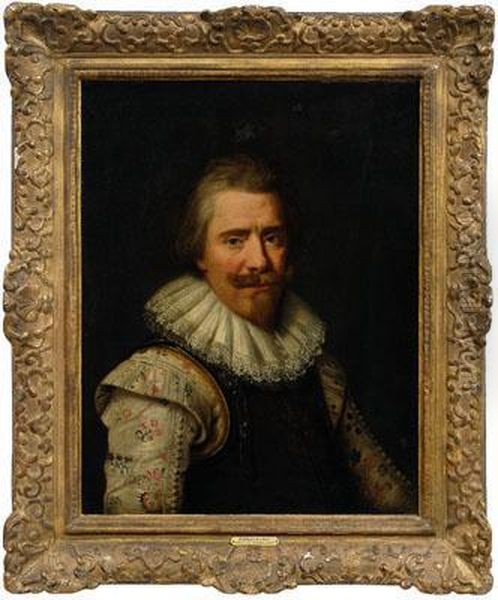
Several artists are known or believed to have studied with Moreelse. The most famous among them is Dirck van Baburen (c. 1595–1624). Baburen began his training with Moreelse around 1611 before traveling to Italy, where he became a leading figure among the Utrecht Caravaggisti, known for his bold, realistic, and often dramatic religious and genre scenes. Although Baburen's mature style differs significantly from Moreelse's more polished manner, his initial training would have provided him with a solid technical foundation.
Moreelse's own son, Johannes Moreelse (after 1602–1634), also became a painter, likely training in his father's workshop. Johannes traveled to Italy as well and seems to have adopted a Caravaggist style, though his oeuvre is small and his career was cut short by an early death. The presence of students like Baburen and his son indicates that Moreelse's workshop was an active center for artistic training in Utrecht. Through his students, even those who developed distinct styles, Moreelse contributed to the continuity and evolution of painting traditions in the city.
Contemporaries and Artistic Milieu
Paulus Moreelse worked within a vibrant artistic community in Utrecht and the broader Dutch Republic. His career overlapped and interacted with numerous other significant painters. His teacher, Michiel Jansz. van Mierevelt (1567–1641) in Delft, remained a dominant force in portraiture throughout much of Moreelse's career. In Utrecht itself, Moreelse's closest associate was arguably Abraham Bloemaert (1566–1651), his co-founder of the Guild of St. Luke. Bloemaert was an incredibly versatile and influential painter and draftsman, known for his Mannerist and later Baroque history paintings and landscapes, and he trained many important artists. Another key Utrecht contemporary was Joachim Wtewael (1566–1638), a leading exponent of late Mannerism, known for his intricate mythological scenes and portraits.
Moreelse also worked alongside the generation of Utrecht Caravaggisti, including his former pupil Dirck van Baburen, Gerard van Honthorst (1592–1656), and Hendrick ter Brugghen (1588–1629). While Moreelse's style was generally less dramatically Caravaggesque, he shared their interest in strong modeling and expressive content, and they all contributed to Utrecht's reputation as a center for history painting with Italianate influences. Other Utrecht contemporaries included Cornelis van Poelenburgh (1594–1667), known for his small, refined Italianate landscapes often featuring mythological figures.
Beyond Utrecht, Moreelse's work existed in the context of masters like Frans Hals (c. 1582–1666) in Haarlem, renowned for his lively and psychologically penetrating portraits, and, of course, Rembrandt van Rijn (1606–1669) in Leiden and Amsterdam, whose profound explorations of light, shadow, and human emotion would eventually dominate the era. Moreelse's connection to Rembrandt, as noted earlier, might have been through his prints. He also interacted with engravers like Jan Saenredam (1565–1607), who reproduced his designs. This network of teachers, colleagues, students, and even rivals formed the rich artistic milieu in which Moreelse thrived.
Later Years and Enduring Legacy
Paulus Moreelse remained active as an artist and influential citizen in Utrecht throughout his later years. He continued to receive prestigious portrait commissions and likely oversaw his workshop's production until shortly before his death. He passed away in his beloved hometown of Utrecht in March 1638 and was buried in the Buurkerk, a testament to his long and successful career rooted firmly in the city. His death occurred in the same year as his contemporary Joachim Wtewael, marking the passing of a generation that had shaped Utrecht's art scene for decades.
Moreelse's legacy is multifaceted. As a portrait painter, he left behind a valuable record of the Dutch elite of his time, captured with elegance and technical skill. His works are held in major museums worldwide, including the Rijksmuseum in Amsterdam, the Centraal Museum in Utrecht, the Louvre in Paris, and the Hermitage in St. Petersburg. His style, balancing Dutch realism with Baroque grace, represented a significant trend in Dutch portraiture, offering a refined alternative to the more rugged realism of Hals or the profound introspection of Rembrandt.
As an architect, his design for the Catharijnepoort introduced a purer form of Classicism to Utrecht, influencing subsequent architectural developments. His role in founding the Guild of Saint Luke and his participation in civic life underscore his importance as a cultural and social figure in Utrecht. Although perhaps overshadowed in popular imagination by the Utrecht Caravaggisti or the giants of Amsterdam and Haarlem, Paulus Moreelse remains a key figure for understanding the diversity and richness of Dutch Golden Age art, particularly the unique artistic climate of Utrecht. His versatility as a painter, printmaker, architect, and civic leader marks him as a truly representative figure of his accomplished era.
Conclusion: A Pillar of Utrecht's Golden Age
Paulus Moreelse emerges from the historical record not just as a painter, but as a cornerstone of Utrecht's cultural and civic life during the Dutch Golden Age. His prolific output of elegant portraits secured his fame and fortune, providing us with invaluable glimpses into the world of the Dutch elite. Yet, his artistic endeavors extended further, encompassing engaging history paintings, skillful graphic works, and pioneering architectural design that embraced the new language of Classicism. His foundational role in establishing the painters' Guild of Saint Luke and his active participation in city governance demonstrate a commitment to his community that complemented his artistic pursuits. By skillfully navigating the artistic currents of his time – absorbing lessons from his Dutch training, Italian travels, and the broader Baroque movement – Moreelse forged a distinct and successful style. His life and work offer a compelling example of the multifaceted roles artists could play in the vibrant society of the 17th-century Dutch Republic, leaving an indelible mark on the art and urban fabric of Utrecht.